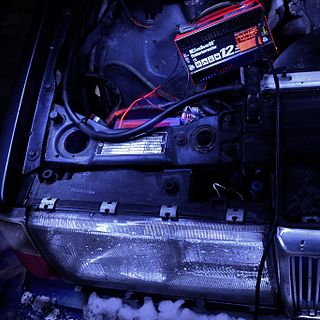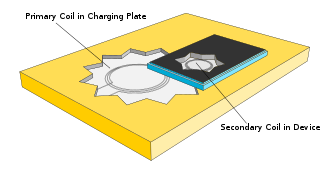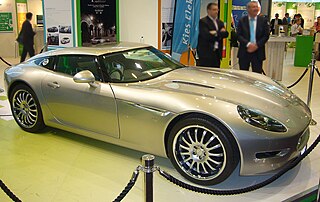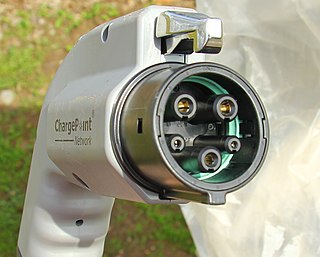Gallery
- zero-xu in 2012
Zero XU is a lightweight electric motorcycle introduced in 2011 by Zero Motorcycles in Scotts Valley, CA. The XU uses the Zero X dirtbike frame, [1] road tires and a lower suspension for street riding.
The 2011 XU has spoked wheels (19" front / 16" rear) and road tires. A bay for a single removable battery module allows for quick swaps or charging away from parking. The XU uses a brushed DC motor and chain drive. The onboard 1 kW charger allows 90+% charging in 2 hours, and an optional quick charge accessory drops the charge time to 1 hour. [2]
In 2012 the XU switched to belt drive and to a single-rotor brushless AC motor, reducing bike maintenance. Battery capacity increased by 50%, and both range and top speed improved. The onboard 1 kW charger allows 95% charging in 3.4 hours, and an optional quick charge accessory allows 95% charging in 1.7 hours. [3]
In 2013 the XU switched to the more powerful 75-5 motor developed by Zero Motorcycles. A second removable battery bay was added, and the XU is now sold as the ZF2.8 and ZF5.7 models with 1 or 2 battery modules installed. When a single battery module is installed, a lockable storage container can be held in the empty bay. The 2013 XU is now capable of highway operation with a maximum speed of 77 mph (124 km/h). The onboard charger is reduced in power to 650W (95% charge in 3.7, 7.4 hours for ZF2.8 and ZF5.7 respectively), but an optional CHAdeMO inlet provides a 1-hour 95% charge for both models. [4]
The XU was discontinued after the 2013 model year.
All specifications are manufacturer claimed.
| 2011 XU | 2012 XU | 2013 XU ZF2.8 | 2013 XU ZF5.7 | |
|---|---|---|---|---|
| Max Power | 4.8 kW (6.4 hp) | 14 hp (10 kW) [5] | 27 hp (20 kW) | 28 hp (21 kW) |
| Max Torque | 22 lbf⋅ft (30 N⋅m) | 42 lbf⋅ft (57 N⋅m) | 42 lbf⋅ft (57 N⋅m) | |
| Top Speed | 51 mph (82 km/h) | 65 mph (105 km/h) | 77 mph (124 km/h) | 77 mph (124 km/h) |
| Weight | 218 lb (99 kg) | 221 lb (100 kg) | 225 lb (102 kg) | 267 lb (121 kg) |
| Capacity (nominal) | 1.7 kWh | 2.6 kWh | 2.5 kWh | 5.0 kWh |
| Range (EPA city) | 25 mi (40 km) | 42 mi (68 km) | 38 mi (61 km) | 76 mi (122 km) |
| Range (55 mph) | 21 mi (34 km) | 24 mi (39 km) | 48 mi (77 km) | |
| Range (70 mph) | 17 mi (27 km) | 35 mi (56 km) | ||
| MSRP | $7695 | $7695 | $7995 | $10490 |

A DC connector is an electrical connector for supplying direct current (DC) power.

The Toyota RAV4 EV is an all-electric version of the popular RAV4 SUV produced by Toyota until 2014. Two generations of the EV model were sold in California, and to fleets elsewhere in the US, with a gap of almost ten years between them.
Hybrid Synergy Drive (HSD), also known as Toyota Hybrid System II, is the brand name of Toyota Motor Corporation for the hybrid car drive train technology used in vehicles with the Toyota and Lexus marques. First introduced on the Prius, the technology is an option on several other Toyota and Lexus vehicles and has been adapted for the electric drive system of the hydrogen-powered Mirai, and for a plug-in hybrid version of the Prius. Previously, Toyota also licensed its HSD technology to Nissan for use in its Nissan Altima Hybrid. Its parts supplier Aisin offers similar hybrid transmissions to other car companies.

The Ford Ranger EV is a battery electric compact pickup truck that was produced by the Ford Motor Company and was the automaker's first all-electric production vehicle. It was produced starting in the 1998 model year through 2002 and is no longer in production. It is built upon a light truck chassis used in the Ford Explorer. Most vehicles were sold with nickel–metal hydride batteries (NiMH). A few vehicles with lead-acid batteries were sold, but most units were leased for fleet use.

A battery charger, recharger, or simply charger, is a device that stores energy in a battery by running an electric current through it. The charging protocol depends on the size and type of the battery being charged. Some battery types have high tolerance for overcharging and can be recharged by connection to a constant voltage source or a constant current source, depending on battery type. Simple chargers of this type must be manually disconnected at the end of the charge cycle. Other battery types use a timer to cut off when charging should be complete. Other battery types cannot withstand over-charging, becoming damaged, over heating or even exploding. The charger may have temperature or voltage sensing circuits and a microprocessor controller to safely adjust the charging current and voltage, determine the state of charge, and cut off at the end of charge. Chargers may elevate the output voltage proportionally with current to compensate for impedance in the wires.

The ZAP Xebra was an electric car launched in May 2006 in the United States market by ZAP corporation. It is classified legally as a three-wheel motorcycle in some jurisdictions, and is available in both sedan and pickup truck variants. It has seat belts. It does not have regenerative braking. The PK pickup has a dump bed, with fold-down sides and tailgate, that allows easy access to the batteries, controller, motor, and charger.

Inductive charging is a type of wireless power transfer. It uses electromagnetic induction to provide electricity to portable devices. Inductive charging is also used in vehicles, power tools, electric toothbrushes, and medical devices. The portable equipment can be placed near a charging station or inductive pad without needing to be precisely aligned or make electrical contact with a dock or plug.

Electric motorcycles and scooters are plug-in electric vehicles with two or three wheels. Power is supplied by a rechargeable battery that drives one or more electric motors. Electric scooters are distinguished from motorcycles by having a step-through frame, instead of being straddled. Electric bicycles are similar vehicles, distinguished by retaining the ability to be propelled by the rider pedaling in addition to battery propulsion.

A charging station, also known as a charge point, chargepoint, or electric vehicle supply equipment (EVSE), is a power supply device that supplies electrical power for recharging plug-in electric vehicles.

The Enertia is an electric motorcycle designed and sold by Brammo, Inc. It uses a Lithium iron phosphate battery, and is intended as a commuter vehicle. Enertia motorcycles first went on sale in late July 2009, and began selling at Best Buy in August 2009.

The Lightning GT was a battery-electric sports car under development by the Lightning Car Company, a London-based privately owned and funded business.

The Mitsubishi i-MiEV is a five-door electric kei car produced in the 2010s by Mitsubishi Motors, and is the electric version of the Mitsubishi i. Rebadged variants of the i-MiEV are also sold by PSA as the Peugeot iOn and Citroën C-Zero, mainly in Europe. The i-MiEV was the world's first modern highway-capable mass production electric car.

Zero Motorcycles Inc. is an American manufacturer of electric motorcycles. Formerly called Electricross, it was founded in 2006 by Neal Saiki, a former NASA engineer, in Santa Cruz, California. The company is now located nearby in Scotts Valley.

SAE J1772, also known as a J plug or Type 1 connector after its international standard, IEC 62196 Type 1, is a North American standard for electrical connectors for electric vehicles maintained by SAE International under the formal title "SAE Surface Vehicle Recommended Practice J1772, SAE Electric Vehicle Conductive Charge Coupler".

Mini Racer RC-12 is 1/12 scale RC car manufactured by Yokomo from 1977 to the early 1980s. It was produced during the brand name change from Yokobori Mokei to Yokomo; even you can see this on the RC-12 box due to on back side of the box had both brands, Yokobori Mokei and the Yokomo labels on it.

CHAdeMO is a fast-charging system for battery electric vehicles, developed in 2010 by the CHAdeMO Association, formed by the Tokyo Electric Power Company and five major Japanese automakers. The name is an abbreviation of "CHArge de MOve" and is derived from the Japanese phrase "o CHA deMO ikaga desuka" (お茶でもいかがですか), translating to English as "How about a cup of tea?", referring to the time it would take to charge a car.

Terry Hershner, nicknamed Electric Terry, is an electric vehicle and renewable energy advocate from Florida. He is known for his long-distance trips and record breaking on his electric motorcycle. He rides a modified production 2012 Zero Motorcycles S ZF9 electric motorcycle, outfitted with a Craig Vetter streamlined fairing. In 2013, he was the first person to cross the United States on an electric motorcycle. In 2014, he became the first ever electric motorcycle rider to go 1000 miles in 24 hours and earn an award from the Iron Butt Association, and was also the first electric motorcycle to win the Craig Vetter Fuel Economy Challenge. Hershner is a board member of the Electric Auto Association, frequent public speaker and radio show guest, and transportation advisor to the international environmental student organization IDEAS for Us.

The adoption of electric vehicles in Hong Kong is actively supported by the Hong Kong government, which recognizes battery electric vehicles, plug-in hybrids, and conventional hybrid electric vehicles to be environmentally friendly and eligible for financial incentives. As of 31 October 2017, there were 11,039 electric vehicles in Hong Kong, up from less than 100 in 2010. At present, 73 EV models from eight countries have been approved by the Transport Department to be eligible for the incentives. These include 51 models for private cars and motorcycles and 22 models for public transport and commercial vehicles.
The initial versions of the USB standard specified connectors that were easy to use and that would have acceptable life spans; revisions of the standard added smaller connectors useful for compact portable devices. Higher-speed development of the USB standard gave rise to another family of connectors to permit additional data paths. All versions of USB specify cable properties; version 3.x cables include additional data paths. The USB standard included power supply to peripheral devices; modern versions of the standard extend the power delivery limits for battery charging and devices requiring up to 240 watts. USB has been selected as the standard charging format for many mobile phones, reducing the proliferation of proprietary chargers.

The Tesla Cyberquad is an electric quad bike all-terrain vehicle (ATV) concept presented by Tesla, Inc., at the Tesla Cybertruck's November 2019 unveiling. Concluding the presentation at the company's design studio in Hawthorne, California, CEO Elon Musk announced "one more thing", at which point the ATV was shown being loaded onto the back of the Cybertruck. Observers have pointed to elements seen at the unveiling indicating that the Cyberquad prototype had been built by swapping the powerplant and plastics on a Yamaha Raptor. Certain images from the rear suggest the vehicle also appears to have a powertrain borrowed from Zero Motorcycles.